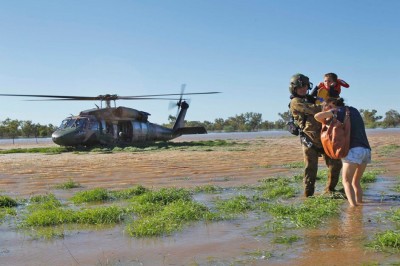The political establishment continues to ignore the slow-burning fuse of global warming. [2 April 2013 | Peter Boyer]

Stretched resources: The Army collects a family from floodwaters during the February 2013 flooding in Charleville in southern Queensland. SOURCE: ABC-TV
Australia’s climate responsiveness must be raised several notches — and quickly — if we are to meet the climate challenges of our region and remain competitive as a trading nation.
These are the messages from reports released last week by two Australian think-tanks, the Australian Strategic Policy Institute (ASPI) and the Climate Institute of Australia. They highlight the huge failure of Australia’s national policy debate to heed the urgency in science’s message that the rising level of carbon dioxide in the air is destabilising our climate, now.
ASPI is an independent institute set up by the Howard government in 2000 to inform government and the wider public on defence issues, generate new ideas and foster expertise in strategic thinking.
“Heavy Weather”, a study by ASPI’s deputy director, Anthony Bergin, and Tony Press, head of the Tasmanian-based Antarctic Climate and Ecosystems CRC, warns that our defence forces urgently need new strategies to meet the challenge from climate changes already under way.
Every summer in recent years, Bergin says, the Australian Defence Force has been required to deploy to floods and bushfires, and now needs to factor in concurrent disasters here and overseas. The report highlights the fact that our Asia-Pacific region is the most disaster-prone region in the world.
“We’re now going to see the ADF really stretched in dealing with extreme weather events,” says Bergin. A rising incidence of extreme weather events and other natural disasters are already forcing the ADF to review its infrastructure and operational capacity to function in hotter, wilder weather. It may even have to abandon its time-honoured tradition of a holiday around Christmas.
In a 2009 White Paper, the ADF argued that climate change wouldn’t be a significant defence issue until at least 2030, and it has resisted following the British and US example in appointing a permanent climate specialist. Wrong on both counts, says the Bergin-Press report.
Australia has also been found wanting by the Climate Institute, whose annual “Global Climate Leadership Review” puts us well down the scale of international “carbon competitiveness”. The review said that while the Gillard government’s Clean Energy Future package caused a “fragile” reversal in Australia’s declining low-carbon competitiveness, we were still lagging well below the top five performers, France, Japan, China, South Korea and the UK.
“The centre of clean energy gravity is shifting to Asia,” says the institute’s CEO, John Connor. China’s very high carbon emissions are counterbalanced by its high-tech exports and investment in clean energy, radically improving its competitiveness in the global low-carbon economy.
Carbon pricing is a factored into the Climate Institute’s assessment. Australia’s $23-a-tonne price rates surprisingly low, close to the bottom of the list, compared to the effective price in place (through a tax, a market mechanism, or other policy measures) in the other 33 OECD member states.
While Tony Abbott argues we should drop our price on carbon, China and South Korea have both announced pricing schemes to come into effect within two years. China’s development and reform supremo Wang Shu has told a US audience that his country’s national scheme would start in 2015.
Nicholas Stern, the eminent British economist, puts a strong case that countries which continue on an “enormously dangerous” carbon-intensive course will seriously damage their competitiveness and prosperity, losing export dollars and other advantages of being in the vanguard of change.
In Tasmania, climate policy tends to be much closer to home — as close as your metre box. The government’s planned energy market restructure includes selling off Aurora Energy to set up two competing non-government suppliers, with the aim of lower bills, safe and secure supply to homes and businesses, and “maximising the value of Tasmania’s low carbon advantage”. The question is, what will this mean for the feed-in tariff, whereby households with standard rooftop solar systems are charged only for the electricity they use over and above what their system generates.
Tasmania’s feed-in tariff has been a significant incentive to go solar, which is getting cheaper as the global market gets bigger. About 10,000 households and a growing number of farms and commercial premises have installed the systems, and have seen their power bills cut accordingly. The official government line is that it’s “considering a range of options” to ensure that customers “continue to receive a fair and reasonable rate” for their solar electricity. Thus the next question, what’s “fair and reasonable”?
Whatever may be said about the efficacy of rooftop solar, a big thing in its favour is the feel-good factor. A full feed-in tariff encourages people to turn their minds to the energy they use by being involved in producing it. And because power is produced close to where it’s used, transmission costs are lower.
While all this is going on — while studies emphasise the rising urgency of effective climate policies and while the future of feed-in tariffs is in question — governments in both Hobart and Canberra are preparing for elections. Both of them are under the hammer, and a change of guard in both capitals looks likely. But the all-important questions around rising carbon emissions and preparing for climate change aren’t getting the hearing they so desperately deserve.
Our political leaders seem to think the electorate puts affirmative climate action low on its to-do list, and that nothing they say will change that. That may prove to be a miscalculation.
